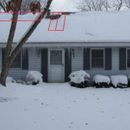Gaps in insulation: effect on total R-value?
We recently had blown in insulation installed in the attic of our Cape Cod style house up to an R-49.
But we do have some gaps that couldn’t be addressed by the blown-in insulation and those are still to be tackled. The picture below was taken prior to the blown in insulation. June was the first full month with the added insulation but we saw no drop in electrical usage from the June 2013. I know there are a lot of variables, but would the insulation gaps in the stairwell and left side kneewalls (to a lesser extent) negate all the added insulation?
The roof has 2×6 roof rafters 16″ OC and there is one rafter bay along the stairway (~10′ long) that has no insulation, and another that has what looks to be some R13 fiberglass batt insulation in it. The stairwell is directly behind the front door and is basically a cathedral type ceiling in that section. The right side bay has a batt of r13 in it and the left side rafter has none in it.
The horizontal line on the left side of the house spans multiple rafters and is part of the knee wall sloped section. The sloped section is is roughly 3′ long and appears to be uninsulated as well. The previous owners may have rolled up some batt insulation and stuffed it in the end of the rafter bay if you want to call that insulation. This sloped area on the second floor is part of the closet for the upstairs bedroom.
Could those areas negate all that added insulation?
We will be having the roof replaced soon, so fixing those areas via outside in is on the to do list.
GBA Detail Library
A collection of one thousand construction details organized by climate and house part











Replies
H.D.S.,
One flaw in your insulation or your air barrier can't "negate" the benefits of insulation installed elsewhere. But if your house has a few glaring, unaddressed flaws, those flaws can be serious enough to constitute a major proportion of your heat loss in winter.
Comparing energy bills from June of one year to June of another year won't tell you much, however, because cooling costs are much more variable than heating costs, and because weather variations have a huge effect on cooling costs.
H.D.S.,
Although you didn't ask this question, you may be wondering: "Can an area with a low R-value have an apparently disproportionate negative effect on the energy performance of a ceiling or roof assembly?"
The answer to this question is yes. For more information, you may want to read this article: Is There a Downside to Lumpy Attic Insulation?
Thanks Martin. Based on your suggestion about the cooling requirements due to outside air temperatures being such a big factor in comparing energy usage, I started trying to find historical data. Initially I graphed the kWh vs daily highs for the month of June 2013 and 2014. Then I came across a site that had cooling degree days using local hourly temperatures and the house desired temperature at 70F. Now that data tracked very well with the kWh's used. In addition, the insulation was installed on June 16th, so only half the month had the savings.
Indeed, June 2013 was cooler than June 2014.
June 2013 there were 11.9 kWh per cooling degree days. (kWh/CDD)
1st half of June 2014 we had 16.6 kWh/CDD
2nd half of June 2014 with insulation, we were at 8.0 kWh/CDD!
With a lot of other electrical demands going on, my wife was baking a lot early in June, some of the numbers are going to be off. Either way, even with the gaps as discussed earlier, there was quite the improvement! This winter will be better as we use gas only for hot water and the furnace and it'll be easy to subtract out the hot water heater gas usage.